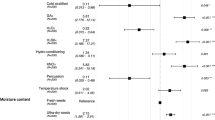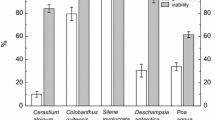Abstract
The timing of seed germination is one of the critical events that determines the success of seedling establishment in wild species in their natural habitat. This is particularly so in species growing in arid and semiarid regions characterized by seasonal rainfall, which is irregular, often with long dry spells. Germination strategies of seeds of Cassia auriculata (Fabaceae, Caesalpinoideae), a perennial weed species of arid and semi-arid regions, were investigated both in petri plate cultures and under field conditions. The results show that seed dormancy is controlled by both physical (impermeable seed coat) and physiological (presence of germination inhibitors) mechanisms. The seeds are capable of withstanding repeated hydration and desiccation cycles during germination. The seeds sown in cultures as well as in the soil do not germinate simultaneously but show staggered germination over a period of several months. Many of the seedlings dry up during intermittent dry periods but many survive in the field during the ensuing summer months until the next rainy season. Staggered germination and ability to withstand repeated hydration and desiccation cycles are important ecological adaptations to maximize seedling establishment under arid and semi-arid environments.


Similar content being viewed by others
References
Baskin CC, Baskin JM (1988) Germination ecophysiology of herbaceous plant species in a temperate region. Am J Bot 75:286–305
Baskin CC, Baskin JM (1998) Seeds: ecology, biogeography, and evolution of dormancy and germination. Academic Press, San Diego
Thompson K (2000) The functional ecology of soil seed banks. In: Fenner M (ed) Seeds: the ecology of regeneration in plant communities, 2nd edn. CABI Publishing, Wallingford
Fenner M, Thompson K (2005) The ecology of seeds. Cambridge University Press, Cambridge
Cao D, Baskin CC, Baskin JM, Fan Y, Huang Z (2013) Dormancy cycling and persistence of seeds in soil of a cold desert halophyte shrub. Ann Bot. doi:10.1093/aob/mct256
Baskin JM, Baskin CC (1980) Ecophysiology of secondary dormancy in seeds of Ambrosia artemishfolia. Ecology 61:475–480
Baskin JM, Baskin CC (1985) The annual dormancy cycle in buried weed seeds: a continuum. Bioscience 35:492–498
Ghazoul J, Sheil D (2010) Tropical rain forest ecology, diversity, and conservation. Oxford University Press, Oxford
Vazquez-Yanes C, Orozco-Segovia A (1990) Seed dormancy in the tropical rain forest. In: Bawa KS, Hadley M (eds) Reproductive ecology of tropical forest plants. UNESCO, Paris and Parthenon Publishing Group, Camforth, pp 247–259
Baker HG (1974) The evolution of weeds. Annu Rev Ecol Syst 5:1–24
Harper J (1977) Population biology of plants. Academic Press, New York
Hnatiuk SH (1979) A survey of germination of seeds from some vascular plants found on Aldabra Atoll. J Biogeogr 6:105–114
Silvertown J (1984) Phenotypic variety in seed germination behavior: the ontogeny and evolution of somatic polymorphism in seeds. Am Nat 124:1–16
Dekker J (2011) Evolutionary ecology of weeds. http://www.agron.iastate.edu/*weeds/PDFLibrary/Agron_517/EEW_ClassUse_1.1.11.pdf.. Accessed 12 Dec 2012
Silvertown J, Charlesworth D (2001) Introduction to plant population biology, 4th edn. Iowa State Press, Ames
Dekker J, Lathrop J, Atchison B, Todey D (2001) The weedy Setaria spp. phenotype: how environment and seeds interact from embryogenesis through germination. In: Proceedings of the Brighton crop protection conference—weeds, pp 65–74
Berrie AMM, Drennan DSH (1971) The effects of hydration and dehydration on seed germination. New Phytol 70:135–142
Baskin JM, Baskin CC (1982) Effects of wetting and drying cycles on the germination of seeds of Cyperus inflexus. Ecology 63:248–252
Hou JQ, Romo JT, Bai Y, Booth DT (1999) Responses of winterfat seeds and seedlings to desiccation. J Range Manag 52:387–393
Kagaya M, Tani T, Kachi N (2005) Effect of hydration and dehydration cycles on seed germination of Aster kantoensis (Compositae). Can J Bot 83:329–334
Hegarty TW (2006) The physiology of seed hydration and dehydration, and the relation between water stress and control of germination: a review. Plant, Cell Environ 1:101–119
Copete MA, Herranz JM, Ferrandis P, Copete E (2015) Annual dormancy cycles in buried seeds of shrub species: germination ecology of Sideritis serrata (Labiatae). Plant Biol. doi:10.1111/plb.12306
Bostock SJ (1978) Seed germination strategies of five perennial weeds. Oecologia 22:113–126
Roberto LB, Rodolfo AS, Forcella F, Kruk BC, Ghersa CM (2000) Environmental control of dormancy in weed seed banks in soil. Field Crops Res 67:105–122
Baskin JM, Baskin CC (1978) The seed bank in a population of an endemic plant species and its ecological significance. Biol Conserv 14:125–130
Dekkers BJW, Costa MCD, Maia J, Bentsink L (2015) Acquisition and loss of desiccation tolerance in seeds: from experimental model to biological relevance. Planta 241:563–577
Turner IM (2001) The ecology of trees in the tropical rain forest. Cambridge University Press, Cambridge
Zalamea PC, Sarmiento C, Arnold AF et al (2015) Do soil microbes and abrasion by soil particles influence persistence and loss of physical dormancy in seeds of tropical pioneers? Front Plant Sci. doi:10.3389/fpls.2014.00799
Kak A, Chitra Devi L, Gupta V, Singh N (2007) Responses of seed treatments on seed germination in wild Crotalaria species. Acta Hortic 752:261–265
Ali H, Tanveer A, Nadeem MA, Asghar HN (2011) Methods to break seed dormancy of Rhynchosia capitata, a summer annual weed. Chil J Agric Res 71:483–487
Vanagamudi K, Bhaskaran M, Balavidhya S, Arthanari PM (eds) (2013) Weed seed biology. Scientific Publishers, Jodhpur
Begum AJM, Vijayakumar A, Selvaraju P (2013) Standardization of seed dormancy breaking treatment in Senna (Cassia auriculata). J Crop Breed Crop Sci 5:220–223
Goggin DE, Powles SB, Steadman KJ (2012) Understanding Lolium rigidum seeds: the key to managing a problem weed? Agronomy 2:222–239
Barrett SCH (2011) Why reproductive systems matter for the invasion biology of plants. Invasiveness may result in a change in community composition. In: Richardson DM (ed) Fifty years of invasion ecology: the legacy of Charles Elton. Blackwell, Chichester, pp 195–210
Shivanna KR (2014) Reproductive assurance through autogamy in some annual weed species. Proc Natl Acad Sci India Sect B Biol Sci 84:681–687
Shivanna KR (2015) Pollination strategies of some perennial weed species. Proc Indian Natl Sci Acad 81:485–492
Shivanna KR (2015) Reproductive assurance through autogamous self-pollination across diverse sexual and breeding systems. Curr Sci 109:1255–1263
Acknowledgments
The author thanks Indian National Science Academy for awarding a position of INSA Honorary Scientist.
Author information
Authors and Affiliations
Corresponding author
Ethics declarations
Conflict of interest
The author does not have any conflict of interest to declare.
Rights and permissions
About this article
Cite this article
Shivanna, K.R. Germination Strategies of Seeds of Cassia auriculata, a Perennial Weed Species of Arid and Semiarid Regions. Proc. Natl. Acad. Sci., India, Sect. B Biol. Sci. 88, 559–566 (2018). https://doi.org/10.1007/s40011-016-0784-1
Received:
Revised:
Accepted:
Published:
Issue Date:
DOI: https://doi.org/10.1007/s40011-016-0784-1




